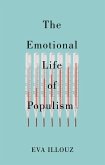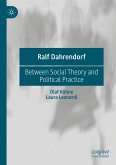Back to the ¿30s?
Recurring Crises of Capitalism, Liberalism, and Democracy
Herausgegeben:Rayner, Jeremy; Falls, Susan; Souvlis, George; Nelms, Taylor C.
Back to the ¿30s?
Recurring Crises of Capitalism, Liberalism, and Democracy
Herausgegeben:Rayner, Jeremy; Falls, Susan; Souvlis, George; Nelms, Taylor C.
- Gebundenes Buch
- Merkliste
- Auf die Merkliste
- Bewerten Bewerten
- Teilen
- Produkt teilen
- Produkterinnerung
- Produkterinnerung
The essays in this volume address the question: what does it mean to understand the contemporary moment in light of the 1930s? In the aftermath of the worst economic crisis since the Great Depression, and facing a dramatic rise of right wing, authoritarian politics across the globe, the events of the 1930s have acquired a renewed relevance. Contributions from a diverse, interdisciplinary group of scholars address the relationship between these historical moments in various geographical contexts, from Asia-Pacific to Europe to the Americas, while probing an array of thematic questions-the…mehr
Andere Kunden interessierten sich auch für
![Back to the ¿30s? Back to the ¿30s?]() Back to the ¿30s?97,99 €
Back to the ¿30s?97,99 €![The Emotional Life of Populism The Emotional Life of Populism]() Eva IllouzThe Emotional Life of Populism17,99 €
Eva IllouzThe Emotional Life of Populism17,99 €![The Everyday Politics of Migration Crisis in Poland The Everyday Politics of Migration Crisis in Poland]() Krzysztof JaskulowskiThe Everyday Politics of Migration Crisis in Poland41,99 €
Krzysztof JaskulowskiThe Everyday Politics of Migration Crisis in Poland41,99 €![Ralf Dahrendorf Ralf Dahrendorf]() Olaf KühneRalf Dahrendorf75,99 €
Olaf KühneRalf Dahrendorf75,99 €![Sociology in the Twenty-First Century Sociology in the Twenty-First Century]() Simon SusenSociology in the Twenty-First Century45,99 €
Simon SusenSociology in the Twenty-First Century45,99 €![The Secular Sacred The Secular Sacred]() The Secular Sacred82,99 €
The Secular Sacred82,99 €![Ralf Dahrendorf Ralf Dahrendorf]() Olaf KühneRalf Dahrendorf75,99 €
Olaf KühneRalf Dahrendorf75,99 €-
-
-
The essays in this volume address the question: what does it mean to understand the contemporary moment in light of the 1930s? In the aftermath of the worst economic crisis since the Great Depression, and facing a dramatic rise of right wing, authoritarian politics across the globe, the events of the 1930s have acquired a renewed relevance. Contributions from a diverse, interdisciplinary group of scholars address the relationship between these historical moments in various geographical contexts, from Asia-Pacific to Europe to the Americas, while probing an array of thematic questions-the meaning of populism and fascism, the contradictions of constitutional liberalism and "militant democracy," long cycles and crisis tendencies in capitalism, the gendering and racialization of right wing movements, and the cultural and class politics of emancipatory struggles. Uncovering continuity as well as change and repetition in the midst of transition, Back to the 30s? enriches our ability to use the past to evaluate the challenges, dangers, and promises of the present.
Produktdetails
- Produktdetails
- Verlag: Palgrave Macmillan / Springer International Publishing / Springer, Berlin
- Artikelnr. des Verlages: 978-3-030-41585-3
- 1st ed. 2020
- Seitenzahl: 452
- Erscheinungstermin: 20. November 2020
- Englisch
- Abmessung: 216mm x 153mm x 29mm
- Gewicht: 698g
- ISBN-13: 9783030415853
- ISBN-10: 3030415856
- Artikelnr.: 58555544
- Herstellerkennzeichnung Die Herstellerinformationen sind derzeit nicht verfügbar.
- Verlag: Palgrave Macmillan / Springer International Publishing / Springer, Berlin
- Artikelnr. des Verlages: 978-3-030-41585-3
- 1st ed. 2020
- Seitenzahl: 452
- Erscheinungstermin: 20. November 2020
- Englisch
- Abmessung: 216mm x 153mm x 29mm
- Gewicht: 698g
- ISBN-13: 9783030415853
- ISBN-10: 3030415856
- Artikelnr.: 58555544
- Herstellerkennzeichnung Die Herstellerinformationen sind derzeit nicht verfügbar.
Jeremy Rayner is on the faculty of the Center for Public Economics and Strategic Sectors at the Instituto de Altos Estudios Nacionales, in Quito, Ecuador. Susan Falls teaches at the Savannah College of Art and Design, USA, and is the author of Overshot: The Political Aesthetic of Textiles (with J. Smith, 2020) and White Gold: Stories of Breast Milk Sharing (2017). George Souvlis is a teaching fellow in history and sociology at the Democritus University of Thrace, Greece. He is theauthor of Voices on the Left (2019). Taylor Nelms, Senior Director of Research at the Filene Research Institute, USA, is co-editor of Journal of Cultural Economy and A Cultural History of Money in the Modern Age (forthcoming).
Part 1: Introduction: Back to the 30s?.-Chapter 1: Introduction: Back to the 30s? .-Part 2-Crises of Capital and Hegemonic Transitions .-Chapter 2: The Spectre of the 1930s .-Part 3: Reading contemporary Latin America in the light of the 1930s: Cycles of accumulation and the politics of passive revolution.-Chapter 3: Reading contemporary Latin America in the light of the 1930s: Cycles of accumulation and the politics of passive revolution .-Part 4: Organic Crisis and Counter-Hegemonic Responses in the Interwar Era and the Era of Memoranda in Greece.-Chapter 4: Organic Crisis and Counter-Hegemonic Responses in the Interwar Era and the Era of Memoranda in Greece.-Part 5: The State of Capitalism and the Rise of the Right in the 1930s and Today: Hungary as a Case Study .-Chapter 5:The State of Capitalism and the Rise of the Right in the 1930s and Today: Hungary as a Case Study .-Part 6: The New Great Transformation: The Origins of Neo-Populism in Light of the Systemic Cycles of Accumulation .-Chapter 6: The New Great Transformation: The Origins of Neo-Populism in Light of the Systemic Cycles of Accumulation .-Part 7-Authoritarianism, Populism, and the Limits of Liberal Democracy .-Chapter 7: Second Time as Farce? Authoritarian Liberalism in Historical Perspective .-Part 8: A Second Foundation? Constitution Nation-Building and the Deepening of Authoritarianism in Turkey .-Chapter 8: A Second Foundation? Constitution Nation-Building and the Deepening of Authoritarianism in Turkey .-Part 9: Hungarian "populism" and antipopulism today through the looking glass of the interwar "populist" movement .-Chapter 9: Hungarian "populism" and antipopulism today through the looking glass of the interwar "populist" movement .-Part 10: Bolsonaro: Politics as Permanent Crisis .-Chapter 10: Bolsonaro: Politics as Permanent Crisis .-Part 11: Rethinking Anti-Fascist Strategy for Today: Historical Lineages of Anti- Communism and "Militant Democracy" in Eastern Europe .-Chapter 11: Rethinking Anti-Fascist Strategy for Today: Historical Lineages of Anti- Communism and "Militant Democracy" in Eastern Europe .-Part 12: People in Movement: Practices , Subjects and Narratives of Political Mobilization .-Chapter 12: Global Crises and Popular Protests: Protest Waves of the 1930s and the 2010s in the Global South .-Part 13: Radical Moderns/Poetry International: Communist Poets in the 1930s .-Chapter 13: Radical Moderns/Poetry International: Communist Poets in the 1930s .-Part 14: Parallel Stories: The rise of the far-right women's movements in the 1930s and 2010s .-Chapter 14. Parallel Stories: The rise of the far-right women's movements in the 1930s and 2010s .-Part 15: (Post-)Fascists, the Constitution, and the Defense of the Italian Nation .-Chapter 15: (Post-)Fascists, the Constitution, and the Defense of the Italian Nation .-Part 16: Radical America: The 1930s and the Politics of Storytelling .-Chapter 16: Radical America: The 1930s and the Politics of Storytelling .-Part 17: Body Politics/Political Bodies: Race, Gender and the Human .-Chapter 17: The Spectre of the 1930s in Asian Nation Building: Global Fascism, Colonial Biopolitics, and the Origins of Modern Asia .-Part 18: From the Old Guard to the Lads Movement: Hybrid Racism and White Supremacism in Australia .-Chapter 18: From the Old Guard to the Lads Movement: Hybrid Racism and White Supremacism in Australia .-Part 19: Sex Work is Work: Greek Capitalism and the 'Syndrome of Electra' 1922-2018.-Chapter 19: Sex Work is Work: Greek Capitalism and the 'Syndrome of Electra' 1922-2018 .-Part 20: Rocks, Rivers, and Robots: Reading Crisis with Teilhard de Chardin .-Chapter 20: Rocks, Rivers, and Robots: Reading Crisis with Teilhard de Chardin .
Part 1: Introduction: Back to the 30s?.-Chapter 1: Introduction: Back to the 30s? .-Part 2-Crises of Capital and Hegemonic Transitions .-Chapter 2: The Spectre of the 1930s .-Part 3: Reading contemporary Latin America in the light of the 1930s: Cycles of accumulation and the politics of passive revolution.-Chapter 3: Reading contemporary Latin America in the light of the 1930s: Cycles of accumulation and the politics of passive revolution .-Part 4: Organic Crisis and Counter-Hegemonic Responses in the Interwar Era and the Era of Memoranda in Greece.-Chapter 4: Organic Crisis and Counter-Hegemonic Responses in the Interwar Era and the Era of Memoranda in Greece.-Part 5: The State of Capitalism and the Rise of the Right in the 1930s and Today: Hungary as a Case Study .-Chapter 5:The State of Capitalism and the Rise of the Right in the 1930s and Today: Hungary as a Case Study .-Part 6: The New Great Transformation: The Origins of Neo-Populism in Light of the Systemic Cycles of Accumulation .-Chapter 6: The New Great Transformation: The Origins of Neo-Populism in Light of the Systemic Cycles of Accumulation .-Part 7-Authoritarianism, Populism, and the Limits of Liberal Democracy .-Chapter 7: Second Time as Farce? Authoritarian Liberalism in Historical Perspective .-Part 8: A Second Foundation? Constitution Nation-Building and the Deepening of Authoritarianism in Turkey .-Chapter 8: A Second Foundation? Constitution Nation-Building and the Deepening of Authoritarianism in Turkey .-Part 9: Hungarian "populism" and antipopulism today through the looking glass of the interwar "populist" movement .-Chapter 9: Hungarian "populism" and antipopulism today through the looking glass of the interwar "populist" movement .-Part 10: Bolsonaro: Politics as Permanent Crisis .-Chapter 10: Bolsonaro: Politics as Permanent Crisis .-Part 11: Rethinking Anti-Fascist Strategy for Today: Historical Lineages of Anti- Communism and "Militant Democracy" in Eastern Europe .-Chapter 11: Rethinking Anti-Fascist Strategy for Today: Historical Lineages of Anti- Communism and "Militant Democracy" in Eastern Europe .-Part 12: People in Movement: Practices , Subjects and Narratives of Political Mobilization .-Chapter 12: Global Crises and Popular Protests: Protest Waves of the 1930s and the 2010s in the Global South .-Part 13: Radical Moderns/Poetry International: Communist Poets in the 1930s .-Chapter 13: Radical Moderns/Poetry International: Communist Poets in the 1930s .-Part 14: Parallel Stories: The rise of the far-right women's movements in the 1930s and 2010s .-Chapter 14. Parallel Stories: The rise of the far-right women's movements in the 1930s and 2010s .-Part 15: (Post-)Fascists, the Constitution, and the Defense of the Italian Nation .-Chapter 15: (Post-)Fascists, the Constitution, and the Defense of the Italian Nation .-Part 16: Radical America: The 1930s and the Politics of Storytelling .-Chapter 16: Radical America: The 1930s and the Politics of Storytelling .-Part 17: Body Politics/Political Bodies: Race, Gender and the Human .-Chapter 17: The Spectre of the 1930s in Asian Nation Building: Global Fascism, Colonial Biopolitics, and the Origins of Modern Asia .-Part 18: From the Old Guard to the Lads Movement: Hybrid Racism and White Supremacism in Australia .-Chapter 18: From the Old Guard to the Lads Movement: Hybrid Racism and White Supremacism in Australia .-Part 19: Sex Work is Work: Greek Capitalism and the 'Syndrome of Electra' 1922-2018.-Chapter 19: Sex Work is Work: Greek Capitalism and the 'Syndrome of Electra' 1922-2018 .-Part 20: Rocks, Rivers, and Robots: Reading Crisis with Teilhard de Chardin .-Chapter 20: Rocks, Rivers, and Robots: Reading Crisis with Teilhard de Chardin .








